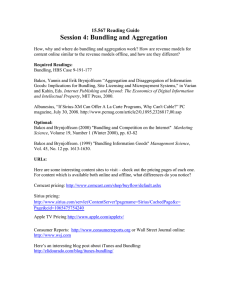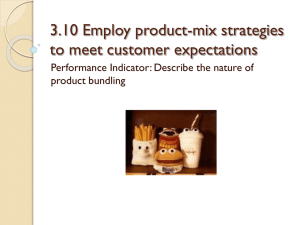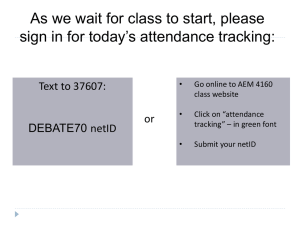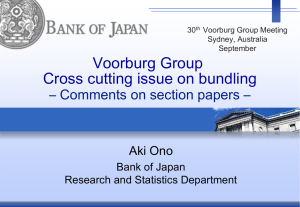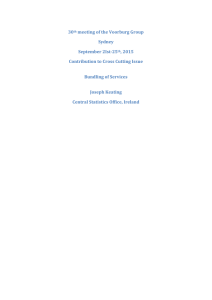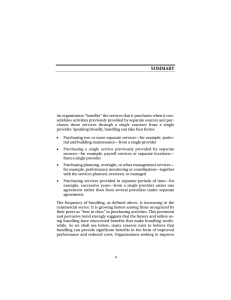Lecture 1
advertisement
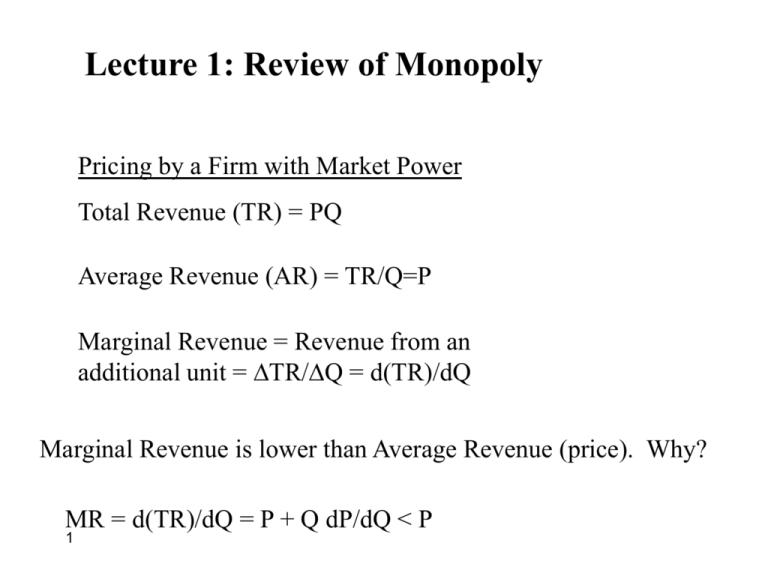
Lecture 1: Review of Monopoly Pricing by a Firm with Market Power Total Revenue (TR) = PQ Average Revenue (AR) = TR/Q=P Marginal Revenue = Revenue from an additional unit = DTR/DQ = d(TR)/dQ Marginal Revenue is lower than Average Revenue (price). Why? MR = d(TR)/dQ = P + Q dP/dQ < P 1 Increase Q if MR > MC Decrease Q if MR < MC Optimum: MR = MC $ $ MR=MC p* D P* MR MC Q Q* 2 Q Q* Example: Automobile Industry Pricing Toyotas. Suppose that the demand for Toyotas is given by P =12000-Q, and MC =$3000. Assume than unit costs are $3000 per vehicle and fixed costs=$7,500,000 TR=PQ= (12000-Q)Q = 12000Q-Q2 MR=12000-2Q TC= 7,500,000 + 3000Q MC=3000 3 MR=MC implies that Q*=4500 Price (from demand curve) = 12000-4500=7500 Profits = PQ - VC - FC Profits = 7500*4500-3000*4500-$7,500,000 Profits = 20,250,000 –7,500,000=$12,750,000 Another way to solve problem p= TR - TC = 12000Q- Q2 - (3000Q + 7,500,000) p = 9000Q - Q2 -7,500,000. d p/dQ = 9000 – 2Q=0 which implies Q*=4500 as before. F Note that the fixed costs only affect the decision 4 whether to produce or not and not how much to produce. Optimal Pricing, margins and the elasticity of demand It can be shown that MR = p + Q dp/dQ = p (1-1/e) From the above equation MR=MC can be rewritten in two ways: margin (p-MC)/p = 1 / e p = MC / (1-1/e) P P D D MR MR MC 5 MC Q + low e, high m Q + high e, low m Example: Automobile Industry Pricing Toyotas in Two Different Markets Market 1 (US) P1 =12000-Q1, MC1 =3000 Market 2 (Japan) P2=14000-2Q2, MC2=2000 Optimal Prices: P(US)=$7500, P(JAPAN)= $8000 Is this dumping? How can the price in the U.S. exceed the price in Japan? e1 = 1.66, -(dQ1 /dP1) P1/Q1 6 e2 = 1.33, -(dQ2 /dP2) P2/Q2 Monopolist with multiple plants Example Demand: P=100-Q Plant 1: TC1=2Q12 Plant 2: TC2=Q22. Optimal MR=MC1=MC2 MC1= 4Q1, MC2=2Q2. MC1=MC2 implies that Q2=2Q1. Q= Q1+Q2 = 3Q1. TR=100Q-Q2. Thus, MR=100-2Q=100-6Q1. 7 MR=MC implies that 100-6Q1=4Q1or Q1=10. Since Q2=2Q1, Q2=20 and Q=30. Check: When Q=30, MR=40, MC1= 4Q1=40 , MC2= 2Q2=40. 8 Bundling Suppose there are two goods (A,B): There are three possible pricing strategies (options:) separate pricing – pA and pB only Pure bundling –pAB only Mixed bundling – pA , pB , and pAB Examples: ‘Hot Triple’ and restaurant pricing Individual Pricing Value of A Buys A only Buys both Buys nothing Buys B only pA pB Value of B Pure Bundling pAB = x Buys bundle Value of A Buys nothing pAB = x Value of B Mixed Bundling I,II,III, IV – buys both; V,VI buys B; VII,VIII buys A VIII pAB=12 pA=8 IV I VII II III 4 VI V 4 pB=8 pAB=12 Profitability of Mixed Bundling • For a monopoly, mixed bundling always (weakly) better than pure bundling • Trade off between mixed bundling and separate pricing • In mixed bundling, price of bundle less than the price of individual goods • Optimal strategy depends on distribution of consumers and costs Example • Cost of entrée (A) = $6, cost of desert (B) =$2 • Three types of consumers with following reservation values: (10,1) (8,4) (5,4) • Individual pricing: pA=8, pB=4, π=2(8-6)+2(4-2)=8 (could also charge pA=10, pB=4, π=(10-6)+2(4-2)=8) • Pure bundling pricing: pAB=11, π=2(11-8)=6 • Mixed bundling pricing: pA=10, pB=4, pAB=11.99, π=(10-6)+(4-2)+(11.99-8)=9.99 • What about pricing bundle at 10.99? π=2(10.99-8)+(4-2) =7.98


